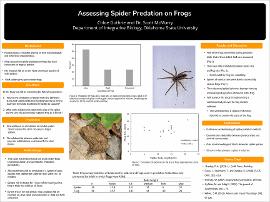| dc.contributor.advisor | McMurry, Scott | |
| dc.contributor.author | Guthrie, Chloe | |
| dc.date.accessioned | 2022-05-03T13:22:33Z | |
| dc.date.available | 2022-05-03T13:22:33Z | |
| dc.date.issued | 2022-04-15 | |
| dc.identifier | oksd_Wentz_2022_guthrie | |
| dc.identifier.citation | Guthrie, C., & McMurry, S. (2022, April 15). Assessing spider predation on frogs. Poster session presented at the Oklahoma State University Wentz Research Scholars Symposium, Stillwater, OK. | |
| dc.identifier.uri | https://hdl.handle.net/11244/335468 | |
| dc.description.abstract | Size is an influential factor in regards to successful predation and it has been concluded that larger sized predators can capture larger prey. Previous studies over spider predation of frogs have consisted of pairing larger spider and frog species together, and smaller spider and frog species together. This was so they could determine if predators could eat prey that was similar to their own size. For our experiment, we expanded on this idea by examining the predator-prey size relations within just one spider species, the wolf spider. This was to eliminate the confounding variable of differing strategic predation methods that vary between species. This study focuses on how the size of wolf spiders can influence their ability to successfully capture prey. The experiment was carried out in a system of glass aquaria where wolf spiders were collected locally and fasted for seven days. Once the fasting period was over, an individual frog was placed into each enclosure where then the 48 hour trial began. At the end of the trial the frog condition was recorded as either alive and untouched, dead and untouched, or dead and consumed. Our data did not generate a correlation between spider and frog size, but instead showed that spiders were able to capture prey that were both smaller and larger than themselves. We plan to next focus on the nutritional aspect of spider predation by running a lipid analysis on the frog remains collected as well as repeating this experiment again using crickets as prey. The results from the lipid analysis over the frog and cricket remains will determine how much nutrients wolf spiders are consuming when they hunt their prey. The importance of this study is that it expands our understanding of the North American species of wolf spider whereas most previous studies have been over tropical spider species. | |
| dc.description.sponsorship | Lew Wentz Foundation | |
| dc.format | application/pdf | |
| dc.language | en_US | |
| dc.publisher | Oklahoma State University | |
| dc.rights | In the Oklahoma State University Library's institutional repository this paper is made available through the open access principles and the terms of agreement/consent between the author(s) and the publisher. The permission policy on the use, reproduction or distribution of the article falls under fair use for educational, scholarship, and research purposes. Contact Digital Resources and Discovery Services at lib-dls@okstate.edu or 405-744-9161 for further information. | |
| dc.title | Assessing spider predation on frogs | |
| osu.filename | oksd_Wentz_2022_guthrie.pdf | |
| dc.description.department | Integrative Biology | |
| dc.type.genre | Poster | |
| dc.type.material | Text | |
| dc.type.material | Image | |
| dc.subject.keywords | wolf spider | |
| dc.subject.keywords | cricket frog | |
| dc.subject.keywords | predation | |
